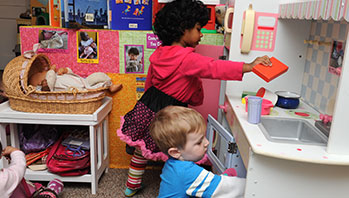- CD or tape player
- music CD or audiotape
- scarves or paper ribbons
- bounce
- bumping
- skidding
- swirling
MA Standards:
Speaking and Listening/SL.PK.MA.1: Participate in collaborative conversations with diverse partners during daily routines and play.
Head Start Outcomes:
Social Emotional Development/Emotional and Behavioral Health: Expresses a range of emotions appropriately, such as excitement, happiness, sadness, and fear.
Approaches to Learning/Cooperation: Joins in cooperative play with others and invites others to play.
Logic and Reasoning/Symbolic Representation: Engages in pretend play and acts out roles.
PreK Learning Guidelines:
English Language Arts/Language 4: Engage in play experiences that involve naming and sorting common words into various classifications using general and specific language.
EEC Infant and Toddler Guidelines
PW50.: The older toddler engages in a variety of physical activities.
River Dance

© Commonwealth of Massachusetts, Department of Early Education and Care (Jennifer Waddell photographer). All rights reserved.
Skill Focus: Creative Movement, Imaginative Play, Vocabulary
Invite children to imagine they are the water in a river, dancing along down from the mountain. Review some of the river’s movements in “River Story.” Say, Let’s listen to and act out some of the words used to describe how the river flows out of the mountains. Act out words such as skidding, bounce, swirling, and bumping.
Play different kinds of music. Encourage children to dance alone or with a partner, silently moving slower or faster as the music dictates. Dancers can use the scarves or paper ribbons to show the flowing movement of the water. Ask other children to be an audience and watch the dances. Be sure they applaud for the dancers at the end.
